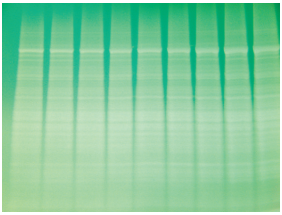Question:
How do you perform protein electrophoresis?
The Protein Man Says:
Now that you know how to choose the most appropriate method in analyzing your protein of interest, let us continue by discussing the next steps involved in protein electrophoresis.
 Sample preparation. Whether you are using a protein sample that has been prepared from a biological sample or one that has been obtained through an earlier step in a purification workflow, you need to make sure that its concentration and the buffer you use are suitable for performing the procedure to ensure accurate results.
Sample preparation. Whether you are using a protein sample that has been prepared from a biological sample or one that has been obtained through an earlier step in a purification workflow, you need to make sure that its concentration and the buffer you use are suitable for performing the procedure to ensure accurate results.
Here are some general considerations when preparing samples for protein electrophoresis:
- Minimize the steps needed in preparing the sample to ensure uniformity.
- Use protease inhibitors when preparing cell or tissue lysates to prevent proteolysis.
- Solubilize the protein sample in a buffer that is compatible with your chosen electrophoresis technique.
- Use a protein assay that is compatible with the chemicals you used to determine the amount of total protein in the sample.
- Remove all traces of any interfering substances through desalting or protein precipitation.
- Use the prepared protein extracts immediately or store them under appropriate conditions.
Gel and buffer preparation. In choosing which gel type to use, you need to consider your overall goals, the gel's compatibility with the properties of the protein under investigation and the analysis technique that you would like to use. You should likewise consider the type of gel and the type of electrophoresis procedure to be used when choosing a suitable buffer to use.
However, since there is not one type of gel or buffer that is suitable for all proteins, you may need to do some tests to come up with the most suitable reagents that will suit your requirements. To help you choose the most suitable reagents for SDS-PAGE, here are some things you may need to consider:
- Use a protein standard that can provide the best resolution for your protein of interest and is compatible with downstream applications.
- Choose a gel percentage that offers the optimum resolution of your sample. Most single percentage gels range from 7.5% to 20% while typical gel gradients range from 4% to 15% and 10% to 20%.
- For best results, use a mini- or midi-format gel when your sample size is limited or when throughput is more important. Use large-format gels if you are after high resolution. On the other hand, you should consider using precast gels if you want greater convenience, reproducibility and superior quality control, and use handcast gels if you want to use customized percentages and gradients.
We will be talking about the actual protein electrophoresis process and how to analyze the results on our next blog so please watch out for it.






